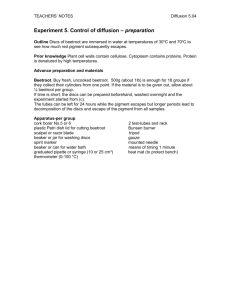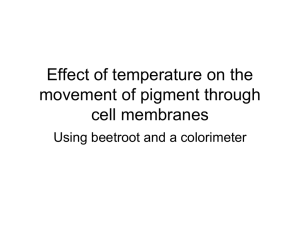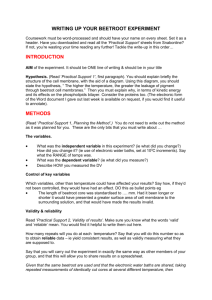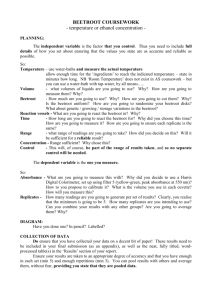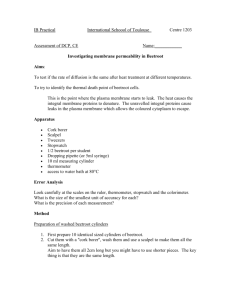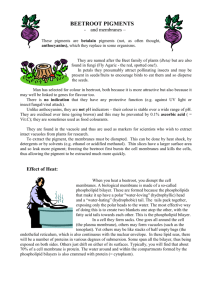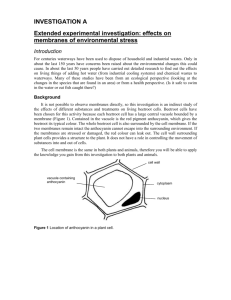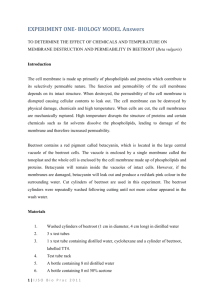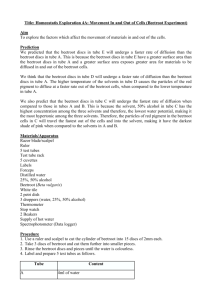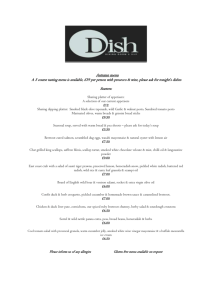Effect of Surface Area on Beetroot diffusion
advertisement
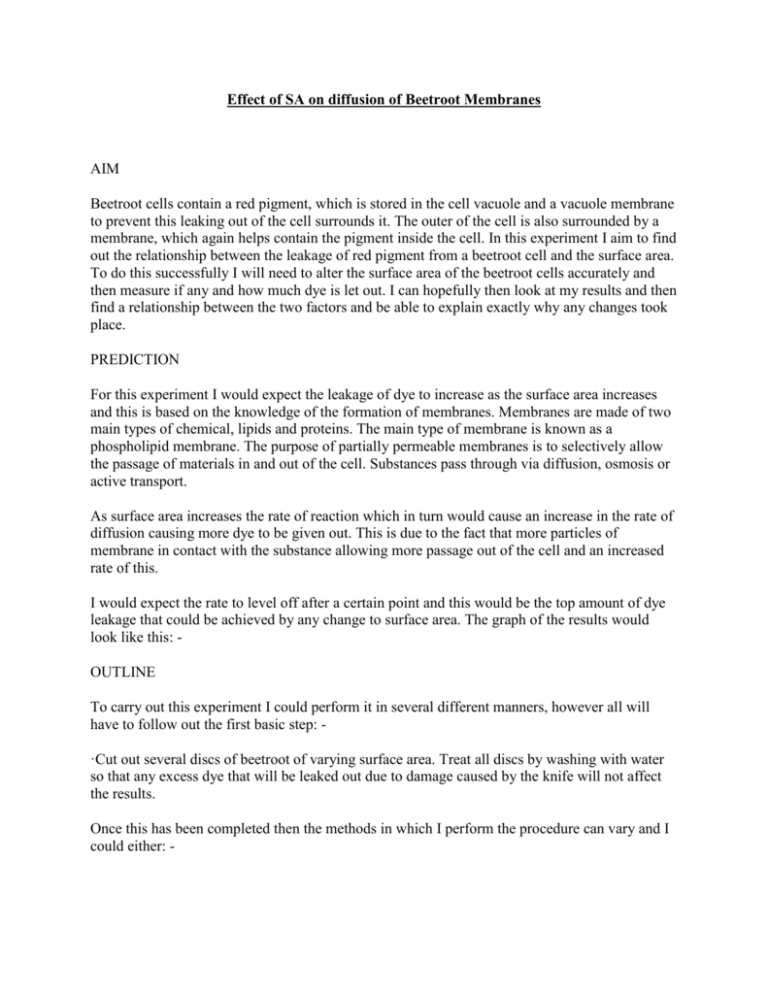
Effect of SA on diffusion of Beetroot Membranes AIM Beetroot cells contain a red pigment, which is stored in the cell vacuole and a vacuole membrane to prevent this leaking out of the cell surrounds it. The outer of the cell is also surrounded by a membrane, which again helps contain the pigment inside the cell. In this experiment I aim to find out the relationship between the leakage of red pigment from a beetroot cell and the surface area. To do this successfully I will need to alter the surface area of the beetroot cells accurately and then measure if any and how much dye is let out. I can hopefully then look at my results and then find a relationship between the two factors and be able to explain exactly why any changes took place. PREDICTION For this experiment I would expect the leakage of dye to increase as the surface area increases and this is based on the knowledge of the formation of membranes. Membranes are made of two main types of chemical, lipids and proteins. The main type of membrane is known as a phospholipid membrane. The purpose of partially permeable membranes is to selectively allow the passage of materials in and out of the cell. Substances pass through via diffusion, osmosis or active transport. As surface area increases the rate of reaction which in turn would cause an increase in the rate of diffusion causing more dye to be given out. This is due to the fact that more particles of membrane in contact with the substance allowing more passage out of the cell and an increased rate of this. I would expect the rate to level off after a certain point and this would be the top amount of dye leakage that could be achieved by any change to surface area. The graph of the results would look like this: OUTLINE To carry out this experiment I could perform it in several different manners, however all will have to follow out the first basic step: ·Cut out several discs of beetroot of varying surface area. Treat all discs by washing with water so that any excess dye that will be leaked out due to damage caused by the knife will not affect the results. Once this has been completed then the methods in which I perform the procedure can vary and I could either: - ·I could cut two pieces of beetroot of different surface area and see how much the results of the leakage varies between these two to find out exactly how many different surface areas I should test in this experiment. ·I could leave two separate samples of beetroot of the same surface area in water for different length periods e.g. 10 and 20 minutes and see which length shows the highest level of dye leakage and this will be the length I will leave my samples in the water in the actual experiment. ·I could also test to see if the leakage of dye worked better in different temperature, e.g if at lower temperatures no dye leaked out I could use higher temperatures from then on. However I am unsure if this will be an applicable method as above 40C the membrane becomes damaged. The method I have decided to use is the first one described, as this will give the most accurate results. VARIABLES There are several variables involved in this experiment and these can either be altered by myself or be measured as a result of the experiment. The variables, which will be altered, are known as independent variables. The variables, which will be measure, are known as dependant variables. In this experiment the independent variable is the surface area, which will be changed. The dependant variable is the leakage of dye, which will be measured to find a relationship between the two. There are also other variables in this experiment, which will need to be controlled to prevent it becoming an unfair test, these are: Temperature - Due to the fact that membranes are made of proteins, temperature is a very important factor. At temperatures above approximately 50°C proteins begin to get destroyed; this would therefore increase the permeability of both the cell wall and the vacuole wall. This would make it impossible for us to distinguish as to whether it was the change in surface area or the temperature that caused any change in dye leakage. For this reason the water used will be at room temperature (23° approx) and will be performed on the same day to allow no margin for any discrepancies. Time - Time is an important factor. When leaving the beetroot in the test tubes it must be ensured that they are in the water for exactly 20 minutes each. This will make sure that the same period of time is given for dye leakage to occur. To control this, putting the beetroot into each test tube two minutes apart will give enough time for them to be removed before the next test tube is ready to have its contents removed. pH - pH can affect the structure of a membrane and therefore cause it to be unable to function efficiently. The pH's, which cause this affect, would be those that are acid or alkaline. Therefore we must use water as our substance as it has a pH 7 and this is neutral and will have no affect on the leakage of pigment. APPARARATUS ·Safety goggles ·Cutting mat ·Test tube holder ·5 test tubes ·2 x 25 ml beaker ·Raw beetroot ·Mounted needle ·Cork borer or scalpel ·Stop watch ·Colorimeter METHOD 1.Collect all the equipment required. 2.Use a cork borer to cut cylinders of raw beetroot. Ensure that all cuts made are at a vertical angle and that each individual slice of beetroot is exactly 3mm in thickness. Cut five discs, as this will provide a good enough range of results to draw a graph and also to make conclusions as to why the results took a certain pattern. If a cut is made of the wrong thickness or the beetroot is not cut at a vertical angle, discard this disk and take another one. 3.Place all the discs into a beaker and wash with water until no more pigment is washed from the slices. 4.Take one disc and place it to the side without further cutting. Now take another disc and cut it precisely in two pieces. Now take another disc and cut this into four pieces. Next take disc and cut it into eight. Repeat this until each disc has been cut into a different number of pieces (doubling each time). 5.Again wash all the pieces until no more pigment is washed out and this ensures that any leakage gained in the next step is caused solely by the change in surface area. 6.Now take a 25ml beaker and fill with distilled water. Then place each of the varying surface areas into a separate test tube of 6cm3 distilled water and time exactly twenty minutes each using a stopwatch to allow time for pigment leakage. 7.Remove pieces of beetroot from test tubes using a mounted need with a wooden handle and then discard them. However be careful not to spill any of the liquid in the test tubes. 8.Set the light transmission level of a colorimeter to 0% using pure water being careful not to get fingerprints onto the tube, as this will affect the amount of light that can pass through. 9.Pour the coloured liquid for the first test tube into a small tube provided with a colorimeter and then place this into the colorimeter. Measure the percentage transmission and then record the results. Repeat this for all of the test tubes. RISK ASSESSMENT In every experiment there are certain dangers, which may be encountered and taking certain precautions can prevent these: ·Pipettes need to be used with precision when being set up. If not used carefully enough when putting the pipette in place it could smash causing you to cut your finger. However this can be prevented if when doing this action you take it slowly and ease it in place without being too hasty. ·Using a scalpel blade to cut the beetroot accurately also gives the problem of cutting yourself with the blade. To prevent this keep your free hand as far away from the blade as possible. Wearing rubber gloves may also help this purpose as they give an extra layer. Also remember to use a cutting mat as this prevents causing damage to the table. ·When utilising the mounted needle be careful to keep your fingers away from the point of it so that it doesn't end up causing any harm to your fingers.
